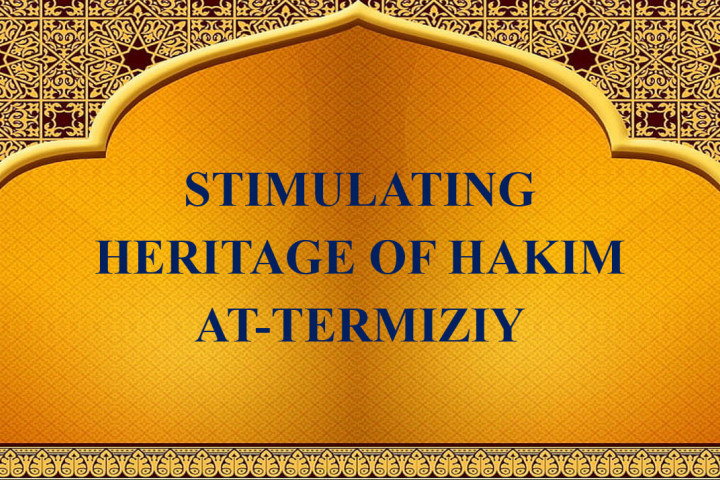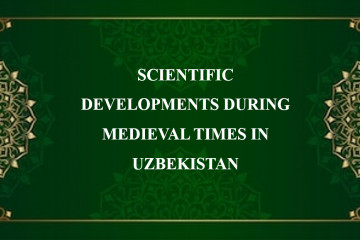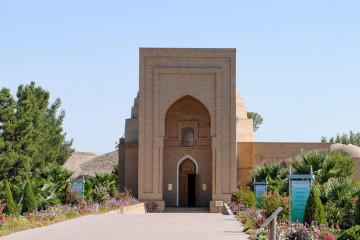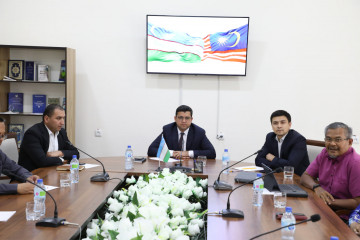
STIMULATING HERITAGE OF HAKIM AT-TERMIZIY
Abu Abdullah Muhammad ibn Ali at-Termizi was born in 750(760), in Termez, - a famous figure of Eastern Sufism, the author of more than 80 works in religion. At-Termizi was nicknamed "Al-Hakim" (wise) because of his deep knowledge and broad outlook.
The full name of this scholar is Abu Abdullah Muhammad ibn Ali ibn Hasan ibn Bashir (in some sources Bishr) al-Hakim at-Termizi. Information about the scientific and creative activity of Hakim at-Termizi Tajiddin Subki ("Tabaqat ash-shafi`-iyya al-Kubro"), Khatib al-Baghdadi ("History of Baghdad"), Ibn Hajar al-Asqalani ("Lison al- mizon”), as-Sulami (“Tabaqat as-Sufiyya”) and a number of other scholars. Hakim al-Tirmidhi describes his life in his book Badu sha'ni Abu Abdullah. This work was published in 1965 in Beirut by Yahya Ismail together with the scholar's work "Khatmul Awliya". The dates of the birth and death of Hakim al-Termizi are given differently in written sources as well as in modern literature. Some authors, such as Haji Khalifa in Kashf az-Zunun, indicated that the year of Hakim al-Termizi's death was 869 AD. The same date is also mentioned on the tombstone of “Alloma”. According to the fact that Hakim al-Termizi lived for more than a hundred years, the sources also say that he lived to 112, 116, or even 120 years, in which case the scholar was born about 750(760) years. Meanwhile, the famous Egyptian scholar Abdulfattah Abdullah Baraka Hakim al-Termizi, who wrote "Al-Hakim at-Termizi and the theory of the elephant kingdom" 30 years ago, was born in 820 AD, lived 112 years and died in 932. Sources do not provide detailed information about Alloma's childhood and adolescence. According to his biography, he was seriously engaged in religious studies from the age of eight, and at the age of twenty-eight he went on a pilgrimage to Mecca. After returning from the journey, Hakim al-Termizi followed the path of Sufism: he went into solitude, overcame his “nafs” and “ammara”, and studied Sufi treatises. His father, Ali ibn Hasan, was an educated muhaddith- scholar who traveled to Baghdad in search of knowledge and actively participated in scholarly discussions with prominent scholars of the time on various issues of hadith. Both his parents and his uncle were considered to be true scholars of hadith. As a result, Hakim al-Termizi grew up in an educated and scientific environment that had a profound effect on his worldview.
Based on written sources describing the life and work of Hakim al-Termizi, his active life can be divided into the following stages:
- The first stage is the childhood up to the age of eight. Unfortunately, we do not have enough information about this period of his life. However, unlike his peers, he did not pay attention to the various games of this age, but prepared himself for future scientific life - learned more from his teachers, studied various sciences (especially theology), immersed himself in a mysterious spiritual life.
- The second stage covers the life of Hakim al-Termizi from the age of eight to twenty-eight. During this time he learned from various sheikhs. In search of knowledge, he traveled to other cities in the East, visited Mecca and made a pilgrimage. During this period of his life, he focused more on the study of hadith and jurisprudence.
- In the third stage of his life, the scholar was engaged in an in-depth study of the Qur'an. He studied kalamullah, its essence, fasting, praying, piety, and so on. Al-Antoki's philosophical work, The Healing of the Heart, was particularly influential.
Hakim al-Termizi also had many disciples. These are: Abu Muhammad Yahya ibn Mansur al-Qazi (died 960), Abu Ali Mansur ibn Abdullah ibn Khalid az-Zuhli al-Hirawi, Abu Ali al-Hasan ibn Ali al-Jurjani, Ahmad ibn Muhammad ibn Isa, Abu Bakr Muhammad ibn 'Umar al-Hakim al-Warraq, Muhammad ibn Ja'far ibn Muhammad ibn al-Haytham ibn Umran ibn Buraydah and others.
Hakim al-Termizi's scientific and creative activity is closely connected with his travels to other countries and cities. He was in Balkh, Nishapur, Baghdad, where science and culture were highly developed. In these cities he met with famous scientists and participated in scientific discussions. However, in the scientific and creative life of Hakim al-Termizi, his hometown, Termez, played a very important role, where he wrote his major works. His sermons, as well as some of his works and, above all, Muslim ceremonies, love of God, certain categories of Sufis, as well as "Khatmul-Awliyya", "Ilal ash-Shari`" are widely spread among the readers. He was welcomed in Balkh and Nishapur by the scholars of that period. Later, his followers and the number of muryd- students increased.
Various figures are given in written sources as to the number of works by Hakim at-Termizi. Some authors estimate that there are four hundred of his works. However, most authors estimate that there are about eighty of his works. According to Abdulfattoh Abdullah Baraka, Hakim at-Termizi has reached about sixty out of four hundred works. Most importantly, we have the works of the scholar, which form the basis of the scientific and spiritual heritage. Among them, first of all, is “Navadir al-usul fi ma'rifat akhbar ar-Rasul”, which contains 291 hadiths. In this play, Hakim al-Termizi's worldview is described to a certain extent. A manuscript copy of "Navodir al-usul" is kept in Tashkent, in the library fund of the Religious Board of Muslims of Uzbekistan. Among the other published works of the scholar are "Kitab haqiqat al-odamiya", "Adab an-nafs". Most of Hakim al-Termizi's works have come down to us in manuscript form and are preserved in various manuscript collections around the world. Manuscripts of his works are kept in Paris, Cairo, Damascus, Alexandria, Istanbul and London. The following works of Hakim at-Termizi are kept in the National Library of Paris (under inventory 5018 in the Arabic section):
1. Kitob as-salot va maqosidiho.
2. Kitob al-hajj va asrorihi.
3. Kitob al-ehtiyotot.
4. Kitob al-jumal al-lozim ma`rifatiho.
5. Kitob al-furuq va man` at-taroduf.
6. Kitob haqiqat al-odamiyya.
7. Kitob urs al-muvahhadiyn.
8. Kitob al-aʼzo val-nafs va yusammo kazalika gʻavr al-umur.
9. Kitob manozil al-ibod min al-ibodati.
10. Kitob al-aql val-havo.
11. Kitob al-amsol min al-Kitob vas-Sunna.
12. Kitob al-manohiy
In Damascus, in the az-Zahiriyya library, the manuscripts of two works and five treatises by Hakim at-Termizi (Sufi series, under No. 104); Three treatises (Maktabat al-Baladiyya, under No. 3585) are preserved in Alexandria, Egypt. The list of Alloma's works preserved in London includes five pamphlets. In Cairo, “Dor al-Kutub al-Ilmiyya” contains a manuscript of “Ilal al-Ubudiyya”. An abbreviated version of the “Kitab as-salat”, this pamphlet is better known as “Ilal al-Shari'a”. The richest heritage of the scientist is being reviewed and studied by the young generation.
Norova Rakhima Fayzulloyevna,
Scientific Researcher in Philological Sciences
Gafurova Norjon Ne’matovna,
Scientific Researcher in Pedagogical Sciences
Bukhara engineering technological institute
References:
- Ahmedov B.A. State Samarkand. – Tashkent: Fan, 1967. – 86.
- Bertels E.E. “Izbrannye trudi”. History of persion-tadjik literatury. – M : Nauka, 1960.
- Imomnazarov M. “Art criticism and typology of genres of classical Persian poetry”. – Tошкент: TSOS, 2015. 319.
- Kholiq Mirzozoda. History of Tajik literature. Book 1 (2). – D: Education, 1987.
- Mirzo Kenjabek. Great Termizies. Tашкент: “National Encyclopedia of Uzbekistan” State Scientific Publishing House, 2017. –528.
- Muhammad Awfi. “Lubob-ul-albob”. – Tehran: Mumtoz, 1361.–1036.
- Nizamii Aro'zii Samarkandī. Four articles. – Dushanbe, 1986.
- Tirmidhi, Munjik. Devon. Ash'ori parokanda. Prepared by Ramazan Abdulloev, author and commentator. – Tashkent: "New edition", 2016. –120.
- Мусулманкулов Р. Персидско-таджикская классическая поэтика. Х–ХВ вв. – М: Наука, 1989.
 УЗ
УЗ
 РУ
РУ
 EN
EN
 العربية
العربية






Оставить комментарий